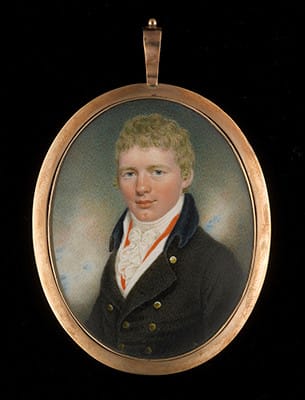
Peter Paillou the Younger
Portrait miniature of a Young Man called Thomas Ritchie, early 19th century
Watercolour on ivory
Oval, 75 mm (2 7/8 ins.) high
Philip Mould & Co.
To view all current artworks for sale visit philipmould.com Information on the life and career of Peter Paillou is surprisingly vague. Paillou trained at the Royal Academy Schools from...
To view all current artworks for sale visit philipmould.com
Information on the life and career of Peter Paillou is surprisingly vague. Paillou trained at the Royal Academy Schools from 1784 and began exhibiting in 1786 until 1800. Previously, no record of Paillou in Scotland prior to 1818 existed , however the present work, which shows a Scottish sitter named Thomas Ritchie, was painted in 1800, meaning that Paillou was already taking commissions, if not living permanently, in Scotland by this point. This fine example, which was until recently in the possession of the sitter’s descendants, is demonstrative of Paillou’s meticulous style which often shows a preference for moody sky backgrounds, frequently adding purples and yellows in isolated areas which gives an intensely luminous evocation. On close inspection, one can notice how the artist first painted the shirt white, and then, with a very fine tool, scratched the white colour away to create the effect of delicate white lace.
The young man’s name is Thomas Ritchie, as identified by an old label of the reverse which states: ‘Thomas Ritchie/of Greenock/ my Grandfather’. There was a boy named Thomas Ritchie who was born in ‘West or Old Parish’ in Greenock, Scotland, in 1784. This would seem logical as the sitter in the present work is certainly around that age. Thomas Ritchie’s parents were Archibald Ritchie and Isabel Malcolm, and, although these two family names feature prominently in early nineteenth century Scottish censuses, any further clues to their identity and life remain as present obscure.
Information on the life and career of Peter Paillou is surprisingly vague. Paillou trained at the Royal Academy Schools from 1784 and began exhibiting in 1786 until 1800. Previously, no record of Paillou in Scotland prior to 1818 existed , however the present work, which shows a Scottish sitter named Thomas Ritchie, was painted in 1800, meaning that Paillou was already taking commissions, if not living permanently, in Scotland by this point. This fine example, which was until recently in the possession of the sitter’s descendants, is demonstrative of Paillou’s meticulous style which often shows a preference for moody sky backgrounds, frequently adding purples and yellows in isolated areas which gives an intensely luminous evocation. On close inspection, one can notice how the artist first painted the shirt white, and then, with a very fine tool, scratched the white colour away to create the effect of delicate white lace.
The young man’s name is Thomas Ritchie, as identified by an old label of the reverse which states: ‘Thomas Ritchie/of Greenock/ my Grandfather’. There was a boy named Thomas Ritchie who was born in ‘West or Old Parish’ in Greenock, Scotland, in 1784. This would seem logical as the sitter in the present work is certainly around that age. Thomas Ritchie’s parents were Archibald Ritchie and Isabel Malcolm, and, although these two family names feature prominently in early nineteenth century Scottish censuses, any further clues to their identity and life remain as present obscure.
Be the first to hear about our available artworks
* denotes required fields
We will process the personal data you have supplied in accordance with our privacy policy (available on request). You can unsubscribe or change your preferences at any time by clicking the link in our emails.